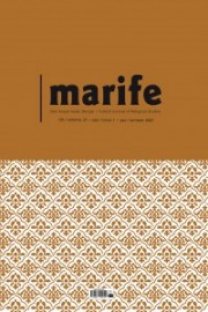İslam Hukukunda Belge Tanziminde Kimlik Tespit Aracı Olarak Hilye: Dış Görünüş Tasvirleri
İslam toplumlarında, hukukî muameleleri kayıt altına almak üzere yazılı belge düzenlenmesine ayrı bir önem verilmiş, muhtemel sahtekârlıkları önlemek üzere belgenin yazımında uzmanları tarafından anlaşılabilen özel bir dil oluşturulmaya çalışılmıştır. Bu çerçevede şürût uzmanları, düzenlenen belgelerde tarafların kimliklerinin tespitinde ve bazı muamelelerde sözleşme konusunun tanımlanmasında ad, nesep, meslek gibi unsurların yanında fiziksel özellikler ve kusurların betimlemesine de yer vermişler, bu özelliklerin ifade edilmesinde ortak bir dil kullanmaya gayret göstermişlerdir. Söz konusu tasvirler şürût eserlerinde çoğunlukla hilâ/hulâ başlığı altında ele alınmıştır. Şürût uzmanları fiziksel özelliklerin tasvirini kimlik tespitinin ana unsurlarından kabul etmezler. Ancak kimlik tespitini kolaylaştıracağı için fiziksel özelliklerin belgede zikredilmesini tavsiye ederler. Bu tanımlamalarda yaş, boy, kafa ve beden yapısı, leke, ben ve organlardaki kusur ve eksikliklerle ilgili ayrıntılı tasvirlere yer verilir. Bu çalışmada, Semerkandî (ö. 550/1155), Tarsûsî (ö. 758/1357), İmâdî (ö. VIII./XIV. yüzyıl), İbn Ferhûn (ö. 799/1397) ve Minhâcî’nin (ö. 889/1484) eserlerinin ilgili bölümleri çerçevesinde söz konusu tasvirler için kullanılan kavramlara ve anlamlarına yer verilecektir.
Anahtar Kelimeler:
İslam Hukuku, İlm-i Şürût, Belgeleme, Kimlik Tespiti, Hilye
Hilye as an Identification Instrument in Documantation in Islamic Law: Descriptions of Physical Qualities
In Islamic societies, a special emphasis has been placed on documentation to ensure the reliability of legal transactions. In documantation, to prevent possible fraud it was created a special language understood especially by experts/ professionals. For this purpose the shurût authorities, in identification of parties in documents in addition to name, genealogy and name of profession make mention of description of physical qualities and defecty. They have tried to use a common language to describe these qualities. These descriptions were covered under the hilâ/hulâ heading in shurût works. Shurût authorities do not accept the description of physical qualities from the main elements of identification. However, they recommend that physical qualities be mentioned in the document in order to facilitate identification. These descriptions include detailed descriptions of age, height, head and body structure, spot, stains and flaws and deficiencies in organs. In this article, within the framework of the relevant sections of the works of Samarqandî (d. 550/1155), Tarsûsî (d. 758/1357), Imâdî (d. VIII./XIV. century), Ibn Farhûn (d. 799/1397) and Minhâcî (d. 889/1484), the words used to express these descriptions and their meanings will be listed.
Keywords:
Islamic Law, Ilm al-Shurût, Documantation, Identification, Hilye,
- Yayın Aralığı: Yılda 2 Sayı
- Başlangıç: 31.05.2001
- Yayıncı: Yediveren Kitap
Sayıdaki Diğer Makaleler
Müslim’in Ehl-i Bid’at Râvilerden Rivayet İle İlgili Durumu
Selim Türcan, Neshin Problematik Tarihi
Ali Kutty MUSLİYAR, Muhammed ÇUÇAK, Arif ATALAY
Yahudi İbadetleri Namaz: Çeşitleri, Vakitleri, Duaları ve Kılınış Şekilleri
Sabâh Nâci EŞ-ŞEYHALÎ, Mustafa ÖLMEZ
Bankaların Memur, İşçi ve Emeklilere Verdiği Maaş Promosyonlarının Fıkhî Durumu
Buhârî’nin Kitâbü’l-Îmân’ı Üzerine Hanefî Bakış Açısı -Bedrüddîn el-Aynî Örneği-
Necis Şeylerin Faydalanılabilirlik Bağlamında Fıkhî Açıdan Değerlendirilmesi
Medeniyet Tasavvurunun Unsurları ve Dinamikleri (Kur’ân Verileri Işığında Bir İnceleme)
Yaratılış ile İlgili Ayetlerin Yorumunda Kelami Paradigmanın Etkisi (Kâdî Abdülcebbâr Özelinde)
